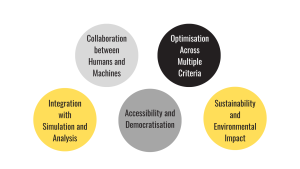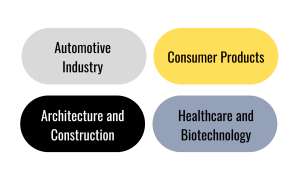content
UI/UX design
February 13, 2024
6 min read
Introduction
Among the many transformative technologies that have emerged in recent years, generative design stands out as a revolutionary approach that is reshaping how designers create and optimise products. As we step into 2024, the role of generative design has become increasingly prominent, offering new possibilities and efficiencies across various sectors. This article delves into the evolution of generative design and explores its profound impact on the design landscape in 2024.
Understanding Generative Design
Generative design is a design methodology that involves using algorithms, computational power, and machine learning to generate countless design iterations based on a set of constraints and objectives. Unlike traditional design methods where designers manually create and iterate designs, generative design relies on computer algorithms to explore a vast design space, uncovering solutions that humans might overlook or find impractical. By harnessing the power of artificial intelligence (AI) and advanced algorithms, generative design enables designers to optimise designs for various factors such as performance, cost, material usage, and manufacturing constraints.
Evolution of Generative Design
Generative design has its roots in computational design and parametric modelling, but its evolution has been fueled by advancements in AI, cloud computing, and simulation technologies. In the early stages, generative design was primarily used in niche industries such as aerospace and automotive, where complex designs and stringent performance requirements necessitated innovative solutions. However, as the technology matured and became more accessible, its applications expanded to diverse sectors including architecture, consumer products, and medical devices.
Key Characteristics of Generative Design in 2024

- Collaboration between Humans and Machines: In 2024, generative design has evolved into a collaborative process where designers work alongside AI-powered tools to explore design possibilities. Rather than replacing human creativity, generative design augments it by leveraging computational power to generate design alternatives rapidly.
- Optimisation Across Multiple Criteria: One of the key strengths of generative design is its ability to optimise designs across multiple criteria simultaneously. Whether it’s minimising material usage, maximising structural efficiency, or reducing manufacturing costs, generative design algorithms can consider a myriad of factors to produce optimal solutions.
- Integration with Simulation and Analysis: Generative design tools in 2024 are seamlessly integrated with simulation and analysis software, allowing designers to evaluate the performance of generated designs in real-time. This integration enables iterative refinement and validation of designs, leading to superior outcomes.
- Accessibility and Democratisation: With the advent of cloud-based generative design platforms, the technology has become more accessible to designers across different industries. Small design teams and independent creators can now leverage the power of generative design without the need for expensive hardware or specialised expertise.
- Sustainability and Environmental Impact: In an era of heightened awareness about sustainability, generative design is playing a crucial role in optimising products for environmental impact. By designing with efficiency and sustainability in mind, companies can minimise waste, reduce energy consumption, and create more eco-friendly products.
Applications of Generative Design in 2024

- Automotive Industry: In the automotive sector, generative design is revolutionising the way vehicles are designed and engineered. From lightweight components to aerodynamic shapes, generative design algorithms are helping automakers optimise performance while meeting stringent safety and regulatory standards.
- Architecture and Construction: Generative design is reshaping the architectural landscape by enabling architects to explore innovative forms and structural solutions. From skyscrapers to bridges, generative design algorithms can generate optimised designs that balance aesthetics, functionality, and structural integrity.
- Consumer Products: In the consumer products industry, generative design is being used to create products that are not only aesthetically pleasing but also highly functional and efficient. From ergonomic furniture to custom wearables, generative design allows designers to tailor products to the unique needs and preferences of consumers.
- Healthcare and Biotechnology: In the field of healthcare, generative design is driving innovation in medical device design, prosthetics, and pharmaceuticals. By optimising designs for patient comfort, usability, and effectiveness, generative design is helping healthcare professionals deliver better outcomes for patients.
Challenges and Future Directions
While generative design holds immense promise, it also presents challenges that need to be addressed. Designers must grapple with issues such as algorithm bias, data privacy, and ethical considerations surrounding AI-driven design. Furthermore, as generative design becomes more prevalent, there is a growing need for education and training to ensure that designers have the skills and knowledge to harness its full potential.
Looking ahead, the future of generative design is likely to be characterised by further integration with emerging technologies such as 3D printing, augmented reality, and advanced materials. As these technologies converge, generative design will continue to push the boundaries of what’s possible, driving innovation and transforming industries in profound ways.
Conclusion
Generative design has emerged as a powerful tool for driving innovation and efficiency across various sectors in 2024. By leveraging the capabilities of AI and advanced algorithms, designers can explore vast design spaces, optimise products for multiple criteria, and unlock new possibilities that were previously unimaginable. As we embrace the transformative potential of generative design, we are witnessing a paradigm shift in how products are conceived, developed, and brought to market, heralding a new era of creativity and innovation in design.
If you have any questions or an idea for a design project, contact us via sales@instandart.com or fill out the form on the main page of the site to discuss.
